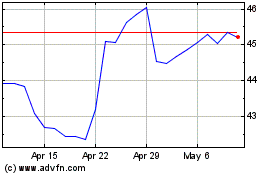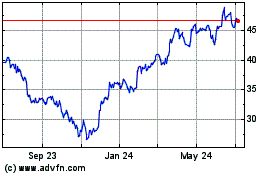Uber to Raise Up to $2 Billion in Leveraged-Loan Market
June 14 2016 - 2:20PM
Dow Jones News
Uber Technologies Inc. is turning to the so-called
leveraged-loan market for the first time to raise as much as $2
billion, in a sign of the popular ride-sharing network's hunger for
cash as it expands around the world.
Uber has hired Morgan Stanley and Barclays PLC to sell a
so-called leveraged loan of $1 billion to $2 billion to
institutional investors, people familiar with the matter said. The
company plans to issue the debt in coming weeks, some of the people
said. There is no guarantee the deal will take place.
The move comes on the heels of Uber's sale of a $3.5 billion
equity stake to the investment arm of Saudi Arabia—part of a $5
billion funding round that was the largest single injection into a
venture-backed company—and underscores the cost of its quest for
global market share. The new loan would bring to roughly $15
billion the amount raised in debt and equity by Uber, which has
been valued at $68 billion.
Uber is hoping to price the loan with a yield of 4% to 4.5%,
some of the people said, but it is unclear whether the company will
achieve a rate that low, especially given it is a first-time
issuer. The average yield on new leveraged loans ranges from 3.9%
to 5.5%, according to data from S&P Capital IQ LCD.
It is unclear what exactly the use of the new funds would be,
but Uber spends millions of dollars to attract riders and drivers,
especially in less-established markets. It offers cash bonuses to
new drivers and subsidizes the cost of lower-priced rides. The
company has said it is profitable in its most developed
markets.
Uber has also been pouring funds into China, where it is engaged
in fierce competition with the country's largest ride-sharing
company, Didi Chuxing Technology Co. Didi itself is in the process
of raising money from equity investors that could top $3.5 billion
and value the company at more than $25 billion.
By placing debt rather than equity, Uber can also avoid diluting
its existing shareholders. Uber Chief Executive Travis Kalanick has
indicated the company is unlikely to go public for at least another
year, which could help explain why it is seeking more unorthodox
sources of funds. Startup technology companies rarely tap the
leveraged loan market because institutional investors usually
reject borrowing requests from companies like Uber that lose money.
Unlike stock pickers who often buy on expectations of future
growth, debt investors focus on a company's ability to generate the
cash it needs to repay obligations.
But Uber and its investment bankers are hoping loan fund
managers will overlook the company's losses because of its lofty
valuation, which is nearly $25 billion more than that of General
Motors Co. A new $2 billion loan would amount to just 3% of Uber's
equity value, and if its business started to falter, the company
could easily raise cash by cutting expenses in peripheral markets,
one of the people said.
Leveraged loans are a private variant of junk bonds. Banks make
the loans to companies with below-investment-grade credit ratings
and offload them to professional investors such as mutual funds,
hedge funds and insurance companies. Issuers of the loans don't
need to publicly report financial information because the debt is
sold privately to investors who are thought to be more
sophisticated.
That privacy is important to Uber, which guards details of its
business such as how much it pays drivers in different cities and
profit margins in core markets.
Banks have been clamoring to assist Uber in raising debt and
equity in hopes of securing a role on an eventual initial public
offering, which will likely represent a major prize on Wall
Street.
In 2015, a consortium of banks arranged a $1.9 billion credit
facility, also known as a revolver, that Uber can tap as needed.
Earlier this year, that facility was refinanced and increased to
$2.3 billion, according to Dealogic.
Write to Maureen Farrell at maureen.farrell@wsj.com, Matt Wirz
at matthieu.wirz@wsj.com and Douglas MacMillan at
douglas.macmillan@wsj.com
(END) Dow Jones Newswires
June 14, 2016 14:05 ET (18:05 GMT)
Copyright (c) 2016 Dow Jones & Company, Inc.
General Motors (NYSE:GM)
Historical Stock Chart
From Mar 2024 to Apr 2024

General Motors (NYSE:GM)
Historical Stock Chart
From Apr 2023 to Apr 2024
